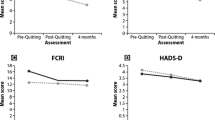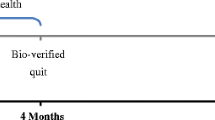Abstract
Background
There has been limited research addressing changes in subjective well-being as a result of quitting smoking.
Purpose
The purpose of this study was to use longitudinal data to determine the relation between smoking cessation and subjective measures of well-being, including global quality of life (QOL), health-related QOL (HR-QOL), affect, relationship satisfaction, and stressor occurrence.
Methods
As part of a randomized, placebo-controlled smoking cessation trial, 1,504 participants (58.2% women, 83.9% white) completed assessments and had their smoking status biochemically confirmed at baseline and years 1 and 3 post-quit.
Results
Compared with continuing smokers, quitters showed improved global QOL, HR-QOL, and affect at years 1 and 3 and fewer stressors by year 3. Smoking status did not influence marital relationship satisfaction.
Conclusions
Successful quitters, in contrast to continuing smokers, reported improved subjective well-being, which could be used to motivate quit attempts by individuals with concerns about what life will be like without cigarettes.
Similar content being viewed by others
References
U.S. Department of Health and Human Services. HHS announces National Smoking Cessation Quitline Network. 2004. www.dhhsgov/news/press/2004pres/20040203html.
Brandon TH, Baker TB. The Smoking Consequences Questionnaire: The subjective expected utility of smoking in college students. Psychol Assess. 1991, 3:484–491.
Copeland AL, Martin PD, Geiselman PJ, Rash CJ, Kendzor DE. Smoking cessation for weight-concerned women: Group vs. individually tailored, dietary, and weight-control follow-up sessions. Addict Behav. 2006, 31:115–127.
Sorensen G, Pechacek TF. Attitudes toward smoking cessation among men and women. J Behav Med. 1987, 10:129–37.
McKee SA, O’Malley SS, Salovey P, Krishnan-Sarin S, Mazure CM. Perceived risks and benefits of smoking cessation: Gender-specific predictors of motivation and treatment outcome. Addict Behav. 2005, 30:423–435.
Chapman S, Wong WL, Smith W. Self-exempting beliefs about smoking and health: Differences between smokers and ex-smokers. Am J Public Health. 1993, 83:215–219.
Mody RR, Smith MJ. Smoking status and health-related quality of life: As findings from the 2001 Behavioral Risk Factor Surveillance System data. Am J Health Promot. 2006, 20:251–258.
Strine TW, Okoro CA, Chapman DP, Balluz LS, Ford ES, Ajani UA, et al. Health-related quality of life and health risk behaviors among smokers. Am J Prev Med. 2005, 28:182- 187.
Tillmann M, Silcock J. A comparison of smokers’ and ex-smokers’ health-related quality of life. J Public Health Med. 1997, 19:268–273.
Wilson D, Parsons J, Wakefield M. The health-related quality-of-life of never smokers, ex-smokers, and light, moderate, and heavy smokers. Prev Med. 1999, 29:139–144.
Turner J, Page-Shafer K, Chin DP, Osmond D, Mossar M, Markstein L, et al. Adverse impact of cigarette smoking on dimensions of health-related quality of life in persons with HIV infection. Aids Patient Care STDS. 2001, 15:615–624.
Mulder I, Tijhuis M, Smit HA, Kromhout D. Smoking cessation and quality of life: The effect of amount of smoking and time since quitting. Prev Med. 2001, 33:653–660.
Mitra M, Chung MC, Wilber N, Klein Walker D. Smoking status and quality of life: A longitudinal study among adults with disabilities. Am J Prev Med. 2004, 27:258–260.
Sarna L, Bialous SA, Cooley ME, Jun HJ, Feskanich D. Impact of smoking and smoking cessation on health-related quality of life in women in the Nurses’ Health Study. Qual Life Res. 2008, 17:1217–1227.
Colditz GA. The nurses’ health study: A cohort of US women followed since 1976. J Am Med Women’s Assoc. 1995, 50:40–44.
Diener E, Suh EM, Lucas RE, Smith HL. Subjective well-being: Three decades of progress. Psychol Bull. 1999, 125:276–302.
Krause JS, Sternberg M. Aging and adjustment after spinal cord injury: The roles of chronologic age, time since injury, and environmental change. Rehab Psychol. 1997, 42:287–302.
Shahab L, West R. Do ex-smokers report feeling happier following cessation? Evidence from a cross-sectional survey. Nicotine Tob Res. 2009 11:553–557.
Frisch MB, Cornell J, Villanueva M, Retzlaff PJ. Clinical validation of the Quality of Life Inventory: A measure of life satisfaction for use in treatment planning and outcome assessments. Psychol Assess. 1992, 4:92–101.
Piper ME, Smith SS, Schlam TR, Fiore MC, Jorenby DE, Fraser D, et al. A randomized placebo-controlled clinical trial of 5 smoking cessation pharmacotherapies. Arch Gen Psychiatry. 2009, 66:1253–1262.
Fiore MC, Jaen CR, Baker TB, Bailey WC, Benowitz N, Curry SJ, et al. Treating tobacco use and dependence: 2008 update. Rockville, MD: U.S. Department of Health and Human Services, U.S. Public Health Service; 2008.
Heatherton TF, Kozlowski LT, Frecker RC, Fagerstrom KO. The Fagerstrom Test for Nicotine Dependence: A revision of the Fagerstrom Tolerance Questionnaire. Br J Addict. 1991, 86:1119–1127.
Shiffman S, Waters A, Hickcox M. The Nicotine Dependence Syndrome scale: A multidimensional measure of nicotine dependence. Nicotine Tob Res. 2004, 6:327–348.
Kawakami N, Takatsuka N, Inaba S, Shimizu H. Development of a screening questionnaire for tobacco/nicotine dependence according to ICD-10, DSM-III-R, and DSM-IV. Addict Behav. 1999, 24:155–166.
Piper ME, Piasecki TM, Federman EB, Bolt DM, Smith SS, Fiore MC, et al. A multiple motives approach to tobacco dependence: The Wisconsin Inventory of Smoking Dependence Motives (WISDM-68). J Consult Clin Psychol. 2004, 72:139–154.
Crits-Christoph P, Gibbons MBC, Ring-Kurtz S, Gallop R, Stirman S, Present J, et al. Changes in positive quality of life over the course of psychotherapy. Psychotherapy. 2008, 45:419–430.
Frisch MB, Clark MP, Rouse SV, Rudd MD, Paweleck JK, Greenstone A, et al. Predictive and treatment validity of life satisfaction and the quality of life inventory. Assessment. 2005, 12:66–78.
Watson D, Clark LA, Tellegen A. Development and validation of brief measures of positive and negative affect: The PANAS scales. J Pers Soc Psychol. 1988, 54:1063- 1070.
Holmes TH, Rahe RH. The Social Readjustment Rating Scale. J Psychosom Res. 1967 11:213–218.
Mitchell SE, Newell GK, Schumm WR. Test–retest reliability of the Kansas Marital Satisfaction Scale. Psychol Rep. 1983, 53:545–546.
Schumm WR, Nichols CW, Schectman KL, Grigsby CC. Characteristics of responses to the Kansas Marital Satisfaction Scale by a sample of 84 married mothers. Psychol Rep. 1983, 53:567–572.
Schumm WR, Paff-Bergen LA, Hatch RC, Obiorah FC. Concurrent and discriminant validity of the Kansas Marital Satisfaction Scale. J Marriage Fam. 1986, 48:381–387.
Schumm WR, Anderson SA, Benigas JE, McCutchen MB, Griffin CL, Morris JE, et al. Criterion-related validity of the Kansas Marital Satisfaction Scale. Psychol Rep. 1985, 56:718.
Ahrens D, Bandi P, Ullsvik J, Moberg DP. Who smokes? A demographic analysis of Wisconsin smokers. WMJ. 2005, 104:18–22.
Baker TB, Piper ME, McCarthy DE, Majeskie MR, Fiore MC. Addiction motivation reformulated: An affective processing model of negative reinforcement. Psychol Rev. 2004, 111:33–51.
Kenford SL, Smith SS, Wetter DW, Jorenby DE, Fiore MC, Baker TB. Predicting relapse back to smoking: Contrasting affective and physical models of dependence. J Consult Clin Psychol. 2002, 70:216–227.
Parrott AC. Acute pharmacodynamic tolerance to the subjective effects of cigarette smoking. Psychopharmacology (Berl). 1994, 116:93–97.
Mino Y, Shigemi J, Otsu T, Tsuda T, Babazono A. Does smoking cessation improve mental health? Psychiatry Clin Neurosci. 2000, 54:169–172.
Stewart AL, King AC, Killen JD, Ritter PL. Does smoking cessation improve health- related quality-of-life. Ann Behav Med. 1995, 17:331–338.
Hendricks PS, Ditre JW, Drobes DJ, Brandon TH. The early time course of smoking withdrawal effects. Psychopharmacology (Berl). 2006, 187:385–396.
Commons KG. Neuronal pathways linking substance P to drug addiction and stress. Brain Res. 2010, 1314:175–182.
Parrott AC. Stress modulation over the day in cigarette smokers. Addiction. 1995, 90:233–244.
Parrott AC. Smoking cessation leads to reduced stress, but why? Int J Addict. 1995, 30:1509–1516.
Parrott AC. Does cigarette smoking cause stress? Am Psychol. 1999, 54:817–820.
Parrott AC. Cigarette-derived nicotine is not a medicine. World J Biol Psychiatry. 2003, 4:49–55.
Parrott AC. Nicotine psychobiology: How chronic-dose prospective studies can illuminate some of the theoretical issues from acute-dose research. Psychopharmacol. 2006, 184:567–576.
Gepner AD, Piper ME, Johnson HM, Fiore MC, Baker TB, Stein JH. Effects of smoking and smoking cessation on lipids and lipoproteins: Outcomes from a randomized clinical trial. Am Heart J. 2011, 161:145–151.
Asthana A, Johnson HM, Piper ME, Fiore MC, Baker TB, Stein JH. Effects of smoking intensity and cessation on inflammatory markers in a large cohort of active smokers. Am Heart J. 2010, 160:458–463.
Johnson HM, Gossett LK, Piper ME, Aeschlimann SE, Korcarz CE, Baker TB, et al. Effects of smoking and smoking cessation on endothelial function: 1-year outcomes from a randomized clinical trial. J Am Coll Cardiol. 2010, 55:1988–1995.
U.S. Department of Health and Human Services. The health benefits of smoking cessation: A report of the Surgeon General. Publication No. (CDC) 90-8416. Rockville, MD: U.S Department of Health and Human Services; 1990.
Acknowledgments
This research was conducted at the University of Wisconsin, Madison, and was supported by grant no. P50 DA019706 from NIH/NIDA and by grant no. M01 RR03186 from the General Clinical Research Centers Program of the National Center for Research Resources, NIH. Dr. Piper was supported by grant 1UL1RR025011 from the Clinical and Translational Science Award (CTSA) program of the National Center for Research Resources (NCRR), National Institutes of Health (NIH). Dr. Baker was supported via NCI 1K05CA139871.
Conflict of interest statement
Drs. Piper, Kenford, and Baker have no potential conflicts of interest to disclose. Over the last 3 years, Michael C. Fiore served as an investigator on research studies at the University of Wisconsin that were funded in part by Nabi Biopharmaceuticals and GlaxoSmithKline. From 1997 to 2010, Dr. Fiore held a University of Wisconsin (UW) named Chair, made possible by a gift to UW from GlaxoWellcome.
Author information
Authors and Affiliations
Corresponding author
About this article
Cite this article
Piper, M.E., Kenford, S., Fiore, M.C. et al. Smoking Cessation and Quality of Life: Changes in Life Satisfaction Over 3 Years Following a Quit Attempt. ann. behav. med. 43, 262–270 (2012). https://doi.org/10.1007/s12160-011-9329-2
Published:
Issue Date:
DOI: https://doi.org/10.1007/s12160-011-9329-2




